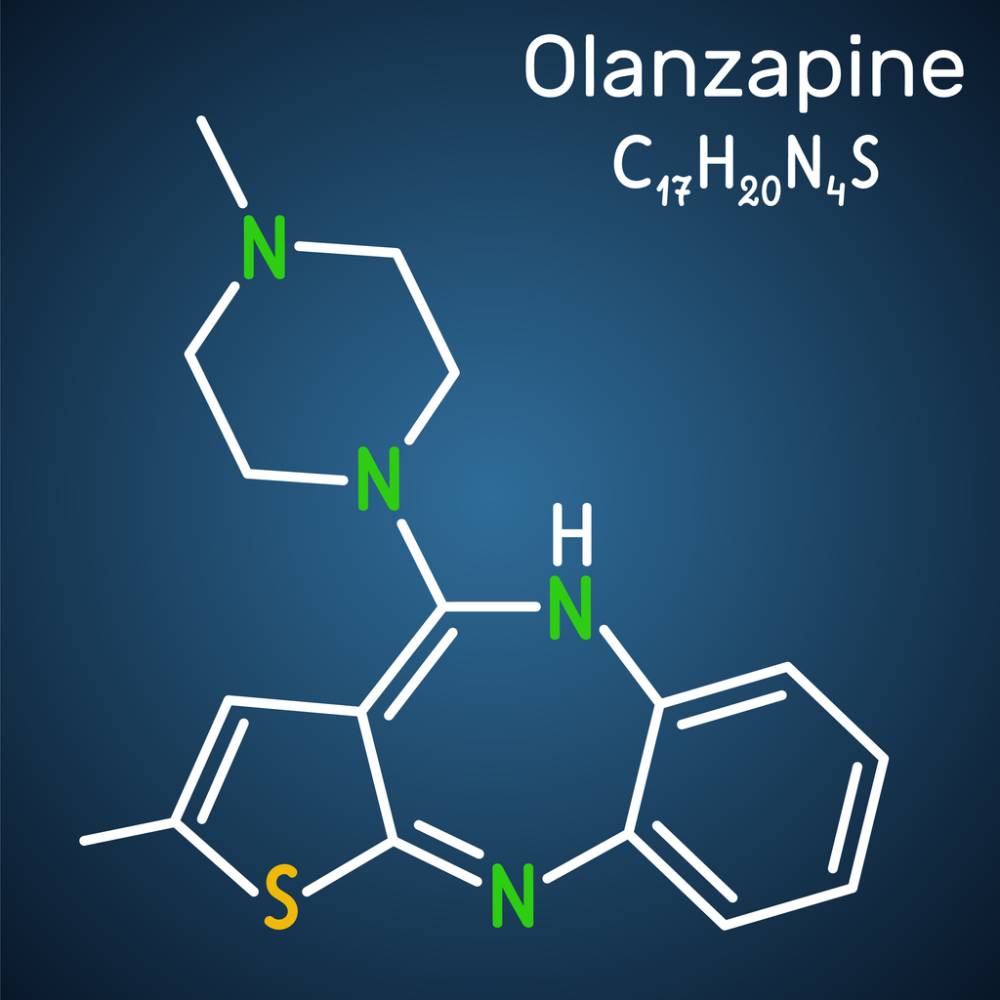Olanzapine is a medication that is most commonly administered for mental and mood disorders such as schizophrenia and bipolar disorder. The drug is categorized as an atypical antipsychotic (also known as a second-generation antipsychotic) because in contrast to earlier antipsychotic drugs, olanzapine exerts its action by interacting with dopamine and serotonin receptors in the brain [1]. Olanzapine can also be used in combination with the drug fluoxetine to treat depression [2]. It is a widely prescribed medication: more than three million prescriptions for olanzapine are filled each year in the United States [3], and it is on the World Health Organization’s List of Essential Medications [4], However, the possible interactions between olanzapine and anesthetics also create a siz
Though olanzapine is overall safe and dangerous side effects are rare, the drug can have harmful interactions with drugs used for anesthesia. Between five and twenty five percent of schizophrenic patients taking antipsychotic drugs experience hypotension (low blood pressure) during and after anesthesia induction.5 Additionally, temperature regulation can be impaired by the combination of certain anesthetic drugs and atypical antipsychotics. Both anesthesia and antipsychotics are associated with a reduction in body temperature; when the two are combined, body temperature can drop significantly. [6]
Despite the risks that can occur when administering anesthesia to patients taking antipsychotic drugs such as olanzapine, many experts recommend that these patients continue taking antipsychotics before and after their operations. [7] Abruptly discontinuing antipsychotics can lead to hallucinations and agitations, and the amount and type of anesthesia can be adjusted to account for antipsychotics. These kinds of considerations, however, vary on a case-by-case basis, and should be made in consultation with one’s doctors.
Though olanzapine is not an anesthetic drug, it can also be administered alongside anesthesia before, during, and after an operation to reduce some of the risks and complications of surgery. One of these complications is postoperative nausea or vomiting, which has been shown to occur in up to 40% of patients with multiple risk factors (which include female sex and a previous history of postoperative nausea and/or motion sickness). [8] Olanzapine is effective at reducing these symptoms; it has proven “anti-emetic behavior.” A recent study by Brazilian and Dutch researchers published in the journal Anaesthesia found that adding pre-operative olanzapine to two other anti-emetic drugs in patients undergoing surgery for oncological diseases was highly effective at reducing post-operative nausea and vomiting in the first 24 hours after surgery. [8] A similar outcome was found in a different study that evaluated the efficacy of olanzapine in patients undergoing breast surgery. [9]
Additionally, olanzapine is effective at treating postoperative delirium, a state of confusion and agitation that can set in anywhere from immediately after an operation to three days later. It is more common in older patients and can prolong hospital stays by up to several days. Researchers from Beth Israel Deaconess Medical Center found that administering olanzapine alongside a standard anesthesia regimen to patients older than 65 undergoing joint-replacement surgery significantly lowered the incidence of postoperative delirium compared to a placebo. [10] Interestingly, delirium lasted longer and was more severe in patients who received olanzapine and nevertheless contracted delirium. Though the mechanisms by which olanzapine exerts all these behaviors are not yet known, it’s clear that it is a versatile drug that warrants further study.
References
- Thomas, K. & Saadabadi, A. Olanzapine. in StatPearls (StatPearls Publishing, 2023).
- Jackson, W. C., Manning, J. S., Connor, P. D. & Deardorff, O. G. Retrospective Study of Olanzapine in Depressive and Anxious States in Primary Care. Prim. Care Companion J. Clin. Psychiatry 6, 199–202 (2004), doi: 10.4088/pcc.v06n0504
- Olanzapine – Drug Usage Statistics, ClinCalc DrugStats Database. https://clincalc.com/DrugStats/Drugs/Olanzapine.
- World Health Organization. The selection and use of essential medicines 2023: web annex A: World Health Organization model list of essential medicines: 23rd list (2023). https://apps.who.int/iris/handle/10665/371090 (2023).
- Kudoh, A., Ishihara, H. & Matsuki, A. Pituitary-adrenal and parasympathetic function in chronic schizophrenic patients with postoperative ileus or hypotension. Neuropsychobiology 39, 125–130 (1999), DOI: 10.1159/000026572
- Kudoh, A. Perioperative Management for Chronic Schizophrenic Patients. Anesth. Analg. 101, 1867 (2005), DOI: 10.1213/01.ANE.0000184123.67853.86
- Kudoh, A., Katagai, H., Takase, H. & Takazawa, T. Effect of preoperative discontinuation of antipsychotics in schizophrenic patients on outcome during and after anaesthesia. Eur. J. Anaesthesiol. 21, 414–416 (2004), DOI: 10.1017/s026502150422511x
- Grigio, T. R. et al. Olanzapine as an add-on, pre-operative anti-emetic drug for postoperative nausea or vomiting: a randomised controlled trial. Anaesthesia 78, 1206–1214 (2023), https://doi.org/10.1111/anae.16081
- Ibrahim, M., Eldesuky, H. I. & Ibrahim, T. H. Oral olanzapine versus oral ondansetron for prevention of post-operative nausea and vomiting. A randomized, controlled study. Egypt. J. Anaesth. 29, 89–95 (2013), https://doi.org/10.1016/j.egja.2013.01.002
- Larsen, K. A. et al. Administration of olanzapine to prevent postoperative delirium in elderly joint-replacement patients: a randomized, controlled trial. Psychosomatics 51, 409–418 (2010), DOI: 10.1176/appi.psy.51.5.409

